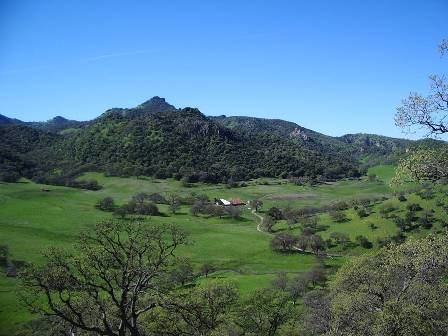Elevation 2122+ feet (647+ m) | Country United States of America Type of rock Volcanic plug | |
 | ||
Listing California county high pt 56th Similar Colusa National Wildlife R, Sacramento National Wildlife R, Delevan National Wildlife R, Caspar Headlands State Bea, William B Ide Adobe State Hist | ||
The Sutter Buttes, formerly known as the Marysville Buttes, are a small circular complex of eroded volcanic lava domes which rise as buttes above the flat plains of the Sacramento Valley in Sutter County, Northern California.
Contents
- Map of Sutter Buttes California 95982 USA
- Natural history
- Geology
- Soils and vegetation
- Native American lore
- Recent history and access
- References
Map of Sutter Buttes, California 95982, USA
The summit of South Butte, at 2122+ feet (647+ m), is the highest point in Sutter Buttes and the highest point in Sutter County. The Buttes are located just outside Yuba City in the Sacramento Valley, the northern part of the Central Valley. Located at the base of the mountain is the small town of Sutter. They are named for John Sutter, who received a large land grant from the Mexican government. The Sutter Buttes are referred to as the world's smallest mountain range.
Natural history
The small range forms a rough circle approximately 10 miles (16 km) from north to south and east to west.
Geology
The Sutter Buttes were formed about 1.6 million years ago in the early Pleistocene Epoch by volcanic activity. The mountains are the remnants of a volcano that has been dormant for over a million years. The eruptions continued until about 1.4 million years ago. Some geological references suggest that it represents the southernmost boundary of the Cascade Volcanoes, but there are significant differences in age and form compared to the other volcanoes in that range. Others suggest that its age places it with the volcanic elements of the California Coast Ranges; its composition is closer to that range but does have significant differences. The volcano is believed to have erupted along a now inactive fault line. The questions about their origin and connection to other regional volcanic activity are the subject of ongoing research.
Soils and vegetation
The rugged central part of the Buttes has a stony brown sandy loam soil of variable depth and good to somewhat excessive drainage. The smoother perimeter has more variable soil with clay or silt loam areas among the sandy loams. These soils support grassland or oak woodland. The Sutter Buttes contain many flora and fauna species. Wildflowers are represented by numerous taxa; included in these many wildflowers is the yellow mariposa lily, Calochortus luteus.
Native American lore
The Sutter Buttes figure prominently in the creation stories and other traditions of the indigenous Maidu and Wintun peoples. The Maidu (or Nisenan) lived to the east of the Buttes and the Wintun (Patwin) to the west. No tribe claimed ownership of the Buttes, and there were only seasonal encampments in the mountain. Native Americans did visit the mountain regularly to gather acorns and other foods or to hunt game. The Buttes were also a center of regional Native American religion. According to anthropologist Alfred Kroeber, the Patwin village where the city of Colusa now stands was the “hotbed” where the Kuksu Cult was established. This religion spread through much of northern California. Ceremonies were performed in earthen dance lodges where spirit impersonators would re-enact ancient mythological events. The Maidu, who lived in their shadow for thousands of years, called them Esto Yamani, which means "the Middle Mountain", the Wintun called the Sutter Buttes Onolai. .
Recent history and access
In the Mexican land grant made to Captain John Sutter, the Sutter Buttes were called "los tres picos" or The Three Peaks. John C. Frémont in 1843 called them "The Three Buttes." During the Gold Rush they acquired the name Marysville Buttes.
Public access to the Sutter Buttes is limited. Almost all of the land is privately held by ranchers and farmers, but an important exception is a 200-acre parcel encompassing most of North Butte, donated by deed from the McClatchy Corporation to the Sutter Buttes Regional Land Trust. The terms of the Deed of Conveyance include the stipulation that the donated land be used for supervised public educational access, not for private use. The deed further stipulates that if these terms of conveyance are violated the land can revert to McClatchy ownership. A few naturalists and local organizations, including Middle Mountain Interpretive Hikes, and the Sutter County Historical Society, lead hikes through some areas. Since 1929, the State of California had considered purchasing the land for protection and a state park.
In 1963, a missile silo complex containing three separate Titan I ICBM missiles was constructed near the base of the Buttes. The site was active from 1963 to 1965, and it was decommissioned and mostly dismantled in 1965. The site has been host to many vandals and trespassers since the early 1980s to the present.
In 2003, the California Department of Parks and Recreation purchased 1,784.5 acres (7.2 km²) in Peace Valley on the north side of the Sutter Buttes with the intent to develop it as a state park. The land did not have a public access. The California Department of Parks and Recreation lists the park's name as unofficial and its current status as closed to the public as of 2017. This land will continue to sit unused for the foreseeable future. The only access to the property is an easement 20 feet wide running about two miles from North Butte Road. The route crosses private lands and is not suitable for the public to enter.
